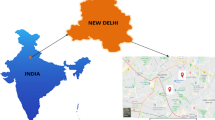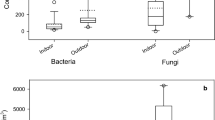Abstract
The qualitative and quantitative measurement of airborne fungi and bacteria in indoor and outdoor air samples has been performed. The concentration level was specific to age of apartment, type of air pollutants, indoor/outdoor type and room type, considering only mean values calculated. When floating microorganisms and precipitating microorganisms were monitored, demonstrating that apartments less than 4 years old (ALT4) showed a 2- to 3-fold lower Indoor/Outdoor (I/O) ratio than apartments more than 4 years old (AMT4) for both floating and precipitating microorganisms. Thereby, high I/O ratio validated that indoor source was high and immediate further investigations were required to improve the indoor air quality of AMT4 apartments. Conclusively, this study provided a monitoring technique and a strategy to develop guidelines to prevent and solve indoor air quality problems in apartment houses. However, it was difficult to evaluate statistical quality of data, as standard deviations (SD) were even higher than mean values or overlapped due to small sample size.
Similar content being viewed by others
References
Lee, J. H. & Jo, W. K. Characteristics of indoor and outdoor bioaerosols at Korean high-rise apartment buildings.Environ. Res. 101, 11–17 (2006).
Kim, Y. S. A study on the current status and prospect of study on indoor air quality.J. Korean Soc. Occup. Environ. Hyg. 15, 371–383 (1999).
Choi, T. & Kim Y. S. A research on the concentration of microorganisms in hospital air.J. Korean Soc. Occup. Environ. Hyg. 19, 30–36 (1993).
Portnoy, J. M.et al. Sampling for indoor fungi.J. Allergy Clin. Immunol. 113, 189–198.
Jo, W. K. & Seo, Y. J. Indoor and outdoor bioaerosol levels at recreation facilities, elementary schools, and homes.Chemosphere 61, 1570–1579 (2005).
Walinder, R.et al. Nasal lavage biomarkers: effects of water damage and microbial growth in an office building.Arch. Environ. Health 56, 30–36 (2001).
Bahnfelth, W. P. & Kowalski, W. J. Indoor-air Quality: Issues and resolutions.HPAC Engineering 6–16 (2005).
Bholah, R. & Subratty, A. H. Indoor biological contaminants and symptoms of sick building. syndrome in office buildings in Mauritius.Int. J. Environ. Health Res. 12, 93–98 (2002).
Haverinen-Shaughnessy, U.et al. Personal and microenvironmental concentrations of particles and microbial aerosol in relation to health symptoms among teachers.J. Expo Sci. Env. Epid. 17, 182–190 (2007).
Kim, Y. S.et al. A study on the distribution of microorganisms in indoor air at multi-purposed facilities.J. Korean Soc. Occup. Environ. Hyg. 28, 85–92 (2002).
Jung, Y. H.et al. A study on the microbiological pollution of living environment and indoor air.J. Korean Soc. Occup. Environ. Hyg. 27, 1–9 (2001).
Kim, K. E. Distribution of fungus spores in indoor and outdoor air.Kor. J. Med. Mycol. 6, 9–16 (2001).
Lee, C. M.et al. A study on the concentration distribution characteristics of microbial aerosols in indoor air within multi-purposed facilities.Kor. Environ. Sci. Soc. 13, 215–222 (2004).
Hwang, G. H.et al. Seasonal changes of the number of microorganisms in indoor air of kindergartens.J. Korean Soc. Microbiol. 39, 253–259 (2003).
Toivola, M.et al. Personal exposures and microenvironmental concentrations of particles and bioaesols.J. Environ. Monit. 4, 166–174 (2002).
Hong J. B. Distribution of hospital airborne microorganisms in Seoul, Korea.Korean J. Environ. Health 29, 1–7 (2003).
Rao, C. Y. & Burge H. A. Review of quantitative standards and guidelines for fungi in indoor air.J. Air Waste Manage. Assoc. 46, 899–908 (1996).
Shelton, B. G. Profiles of airborne fungi in buildings and outdoor environments in the United States.Appl. Environ. Microbiol. 68, 1743–1753 (2002).
Kung’u, J. Guidelines for interpreting numerical data of non-viable (spore traps) and viable airborne mould samples.Mould & Bacteria Reviews Issue #5: Part I. (2005).
Lee, J. H. & Jo, W. K. Characteristics of indoor and outdoor bioaerosols at Korean high-rise apartment buildings.Environ. Res. 101, 11–17 (2006).
Author information
Authors and Affiliations
Corresponding author
Rights and permissions
About this article
Cite this article
Jeon, H.L., Kim, J.H., Cho, T.J. et al. Assessment of airborne bioaerosols in korean apartment houses. Toxicol. Environ. Health. Sci. 2, 268–273 (2010). https://doi.org/10.1007/BF03217493
Accepted:
Issue Date:
DOI: https://doi.org/10.1007/BF03217493




